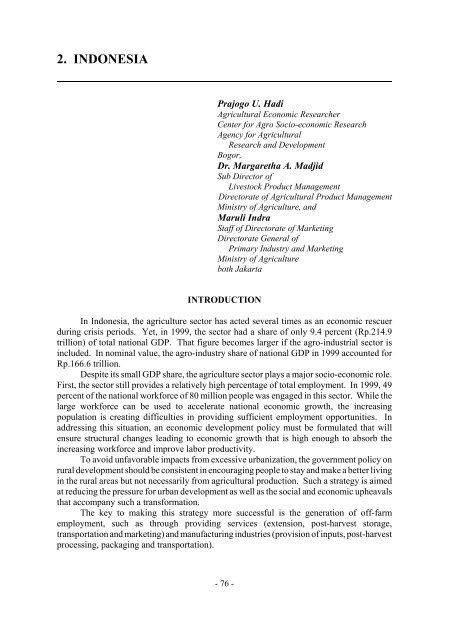Development of Agribusiness Enterprises - Asian Productivity ...
Development of Agribusiness Enterprises - Asian Productivity ...
Development of Agribusiness Enterprises - Asian Productivity ...
Create successful ePaper yourself
Turn your PDF publications into a flip-book with our unique Google optimized e-Paper software.
2. INDONESIA<br />
Prajogo U. Hadi<br />
Agricultural Economic Researcher<br />
Center for Agro Socio-economic Research<br />
Agency for Agricultural<br />
Research and <strong>Development</strong><br />
Bogor,<br />
Dr. Margaretha A. Madjid<br />
Sub Director <strong>of</strong><br />
Livestock Product Management<br />
Directorate <strong>of</strong> Agricultural Product Management<br />
Ministry <strong>of</strong> Agriculture, and<br />
Maruli Indra<br />
Staff <strong>of</strong> Directorate <strong>of</strong> Marketing<br />
Directorate General <strong>of</strong><br />
Primary Industry and Marketing<br />
Ministry <strong>of</strong> Agriculture<br />
both Jakarta<br />
INTRODUCTION<br />
In Indonesia, the agriculture sector has acted several times as an economic rescuer<br />
during crisis periods. Yet, in 1999, the sector had a share <strong>of</strong> only 9.4 percent (Rp.214.9<br />
trillion) <strong>of</strong> total national GDP. That figure becomes larger if the agro-industrial sector is<br />
included. In nominal value, the agro-industry share <strong>of</strong> national GDP in 1999 accounted for<br />
Rp.166.6 trillion.<br />
Despite its small GDP share, the agriculture sector plays a major socio-economic role.<br />
First, the sector still provides a relatively high percentage <strong>of</strong> total employment. In 1999, 49<br />
percent <strong>of</strong> the national workforce <strong>of</strong> 80 million people was engaged in this sector. While the<br />
large workforce can be used to accelerate national economic growth, the increasing<br />
population is creating difficulties in providing sufficient employment opportunities. In<br />
addressing this situation, an economic development policy must be formulated that will<br />
ensure structural changes leading to economic growth that is high enough to absorb the<br />
increasing workforce and improve labor productivity.<br />
To avoid unfavorable impacts from excessive urbanization, the government policy on<br />
rural development should be consistent in encouraging people to stay and make a better living<br />
in the rural areas but not necessarily from agricultural production. Such a strategy is aimed<br />
at reducing the pressure for urban development as well as the social and economic upheavals<br />
that accompany such a transformation.<br />
The key to making this strategy more successful is the generation <strong>of</strong> <strong>of</strong>f-farm<br />
employment, such as through providing services (extension, post-harvest storage,<br />
transportation and marketing) and manufacturing industries (provision <strong>of</strong> inputs, post-harvest<br />
processing, packaging and transportation).<br />
- 76 -
















